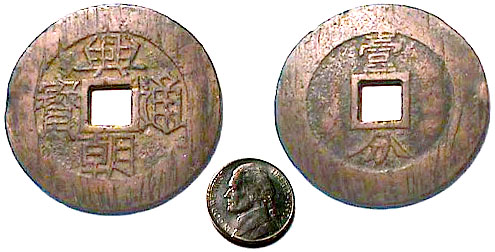興朝通寶
The Peasant Rebel Anmy Coinage
| I post below is an email received from MR. C. Sachjen of U.S.A. on 07 May 2000. The email is self-explanatory. Subject: Chinese Numismatics Date: Sun, 07 May 2000 17:43:25 -0400 Sir: Could you please assist me in identifying this coin? All I know is that it is a 1 Fen and was issued under Tsing-Tao (?). Just click once on the address and your browser will open up the picture. Thanks in advance for your help. http://www2.dmci.net/users/sachjen/bigchina.jpg Sincerely, C. Sachjen If you know anything or If you want to share your knowledge and enthusism in this hobby, feel free to drop me a line. Thank you in advance. YKL |
Extremely Rare A ~ Very Rare B ~ Rare C ~ Not So Many D ~ Common E

|
There is a very interesting legend about "Hsing Ch'ao T'ung Pao" cash in Chinese numismatic history. When Sun K'e Wang entered Yunnan Province with his army, he found that there was a very big copper cow of weighed more than ten thousand catties in Tung Kuo 東廓 of Yunnan Province. [one catty = 0.5 kilogram]. The big copper cow was just suitable for melting down to cast cash to pay to his army.
Although the use of shells as media of exchange had lasted more than two thousand years in Yunnan province, when the peasant rebel armies of Sun K'e Wang 孫可望 entered Yunnan province in 1647, shells were forbidden using as legal tender again. People used copper cash instead of shells. On the obverse of this cash is the legend of "Hsing Ch'ao T'ung Pao" in direct reading or symmetric reading. Hsing Ch'ao T'ung Pao cash were issued in three values, one cash, five cash and ten cash. The five-cash one has on the reverse the Chinese characters Wu-li 五厘 [means five hundred part of a tael, indicating the value of silver] This cash is one candareen cash bearing on the reverse are Chinese characters I-fen 壹分 [means a hundred part of a tael, indicating the value of silver.] Chinese cash of these types are known as Ch'uen Yin Ch'ien 權銀錢 "Hsing Ch'ao T'ung Pao" is not rare coin, and is worth about US$8-10 in very fine condition. |